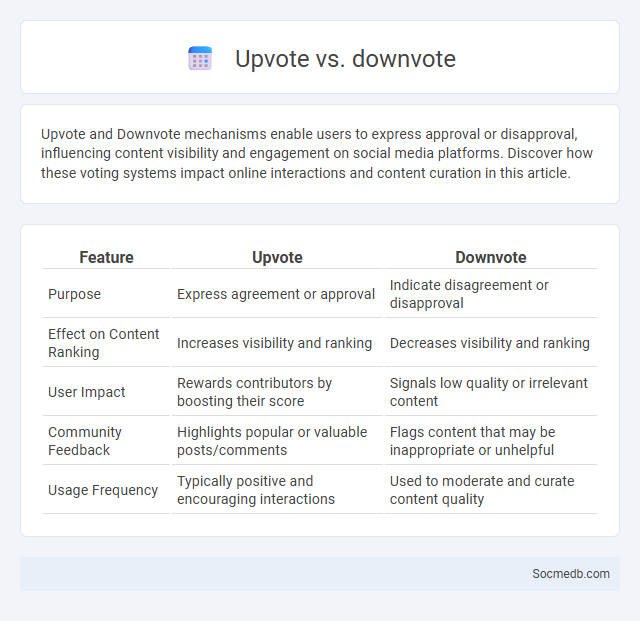
Photo illustration: Upvote vs Downvote
Upvote and Downvote mechanisms enable users to express approval or disapproval, influencing content visibility and engagement on social media platforms. Discover how these voting systems impact online interactions and content curation in this article.
Table of Comparison
| Feature | Upvote | Downvote |
|---|---|---|
| Purpose | Express agreement or approval | Indicate disagreement or disapproval |
| Effect on Content Ranking | Increases visibility and ranking | Decreases visibility and ranking |
| User Impact | Rewards contributors by boosting their score | Signals low quality or irrelevant content |
| Community Feedback | Highlights popular or valuable posts/comments | Flags content that may be inappropriate or unhelpful |
| Usage Frequency | Typically positive and encouraging interactions | Used to moderate and curate content quality |
Understanding Upvotes and Downvotes: Core Concepts
Upvotes and downvotes are key indicators of user engagement on social media platforms, reflecting the approval or disapproval of content by your audience. These voting mechanisms influence the visibility and ranking of posts, making them essential for shaping your online presence and community interaction. Understanding how upvotes and downvotes affect algorithms helps optimize content strategy for maximum reach and impact.
The Purpose of Upvotes in Online Communities
Upvotes in online communities serve as a vital mechanism to highlight valuable content and enhance user engagement. They help You identify the most relevant and trustworthy posts, fostering a collaborative environment where quality contributions rise to prominence. By signaling consensus and approval, upvotes promote content visibility and encourage active participation within social media platforms.
The Role of Downvotes: When and Why to Use Them
Downvotes serve as a crucial tool for maintaining content quality on social media platforms by signaling inaccurate, irrelevant, or harmful posts. You should use downvotes strategically to discourage misinformation and promote constructive discussions, ensuring that valuable information gains visibility. Overusing downvotes can lead to negativity, so it's important to apply them thoughtfully to balance community engagement and content integrity.
Comparing the Impact: Upvote vs Downvote on Content Visibility
Upvotes significantly boost content visibility by signaling quality and relevance to algorithms, increasing the likelihood of wider dissemination across social media platforms. Downvotes, conversely, decrease content exposure, often flagging posts for review or demotion in user feeds, which limits audience reach and engagement potential. The balance between upvotes and downvotes shapes algorithmic prioritization, directly influencing content popularity and platform dynamics.
Common Misuses of Voting Systems
Common misuses of voting systems on social media include spreading misinformation that skews public perception and manipulating polls through coordinated bot attacks or fake accounts. These actions compromise the integrity of online surveys and voting mechanisms, leading to inaccurate results that fail to represent genuine public opinion. Understanding these risks helps protect your participation and promotes more reliable digital enfranchisement.
Psychological Effects of Upvotes and Downvotes
Upvotes and downvotes on social media platforms significantly influence user behavior and self-esteem by triggering reward and punishment systems in the brain. Positive feedback through upvotes can enhance feelings of social validation and motivation, while downvotes may lead to anxiety, decreased self-worth, and social withdrawal. Understanding these psychological effects is essential for designing healthier online interactions and mitigating negative mental health outcomes.
Upvote vs Downvote: Best Practices for Users
Upvote and downvote functions play a crucial role in shaping content visibility and community engagement on social media platforms. Your strategic use of upvotes enhances the reach of valuable posts, while thoughtful downvotes help filter out low-quality or irrelevant content, promoting a healthier online environment. Understanding when and how to apply these voting tools maximizes your influence and supports a more meaningful dialogue.
Consequences of Excessive Downvoting
Excessive downvoting on social media platforms can lead to decreased user engagement and the suppression of diverse opinions, causing algorithmic bias that favors popular content disproportionately. This behavior often results in negative online environments, where users feel discouraged from sharing unique perspectives, hampering the overall quality of discourse. Platforms leveraging machine learning for content ranking may unintentionally reinforce echo chambers, reducing exposure to balanced viewpoints and hindering community growth.
Platform Policies on Voting Behavior
Social media platform policies significantly influence voting behavior by regulating political content and mitigating misinformation. Algorithms prioritize credible information, while content moderation enforces community guidelines to prevent election interference. These measures aim to foster informed voter participation and uphold electoral integrity.
Creating a Healthier Voting Culture Online
Creating a healthier voting culture online requires promoting digital literacy to combat misinformation and encouraging respectful political discourse across social media platforms like Twitter, Facebook, and Instagram. Social media algorithms must prioritize credible news sources and fact-checking organizations to reduce the spread of false information that can influence voter behavior. Engaging community leaders and influencers to model positive, informed discussions can enhance voter trust and participation in the democratic process.
 socmedb.com
socmedb.com